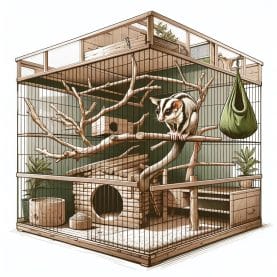Imagine unlocking the secret to keeping a sugar glider pet happy and healthy in your home. That’s exactly what we’re diving into today. We’ll walk you through crafting the perfect habitat for these tiny, energetic creatures, from cage essentials to safety tips that are often overlooked.
You’ll also get a crash course on their diet – think beyond just fruits and nuts to create balanced meals that mimic their natural intake. Plus, we tackle common health issues head-on, giving you proactive strategies to keep them at bay.
But it’s not all sunshine; owning a sugar glider pet comes with its unique set of challenges alongside the joys. By comparing them with other exotic pets, we aim to paint a clear picture of whether this fascinating companion is right for you.
Table Of Contents:
- Legal and Ethical Considerations for Owning a Sugar Glider
- Crafting the Ideal Habitat for Your Sugar Glider Pet
- The Balanced Diet of a Sugar Glider
- Common Health Issues in Sugar Gliders
- Pros and Cons of Sugar Glider Ownership
- Comparing Sugar Gliders to Other Exotic Pets
- A Sugar Gilder Pet Takes Special Care
 AI illustration of a Sugar Glider Pet at home
AI illustration of a Sugar Glider Pet at home
Legal and Ethical Considerations for Owning a Sugar Glider
Owning a sugar glider can be an enriching experience, but it’s essential to understand the legal and ethical considerations before bringing one into your home. This section will explore whether sugar gliders are legal pets in your area, space requirements, and the commitment needed to provide proper care.
Are Sugar Gliders Legal in Your Area?
The legality of owning a sugar glider varies by location. In some places, they are considered exotic animals and may require special permits or might even be banned altogether. It is crucial to check with local regulations before acquiring a sugar glider as a pet. For more information on the legality of exotic pets in different regions, you might want to consult resources like the Animal Law Resource Center.
Housing Requirements: Do You Have Enough Space?
Sugar gliders need ample space to climb and glide as these activities are vital for their physical health and well-being. A large cage—at least 24 inches wide by 24 inches deep by 36 inches high—is necessary; however, bigger is always better when it comes to their habitat. Additionally, creating an environment that mimics their natural habitat with branches or vines can significantly enhance their quality of life.
Time Commitment: Are You Ready To Provide Adequate Care?
Caring for sugar gliders requires time, patience, and dedication. These nocturnal creatures thrive on social interaction either with other sugar gliders or human companionship during evenings when they’re most active. Their diet consists mainly of fruits, nectar-like supplements, and protein sources such as insects—requiring daily preparation.Besides dietary needs, sugar gliders demand regular grooming, veterinary check-ups, and attention to prevent loneliness/depression. It’s imperative potential owners assess if they have enough time/energy/resources to commit long-term since these small mammals live up-to 12-15 years under optimal conditions.
To ensure you’re making an informed decision about adopting this unique companion animal, research extensively, equip yourself with knowledge from credible sources, and consider all aspects discussed above. Owning any pet is not just about enjoyment but also entails responsibility towards another living being’s welfare.
Crafting the Ideal Habitat for Your Sugar Glider Pet
Creating a home for your sugar glider is more than just setting up a cage. It’s about making a space where they can thrive, not just survive. Think of it as designing an amusement park where safety meets fun.
Cage Size and Design
The mantra ‘bigger is better’ rings true when selecting a cage for your sugar glider. A tall, vertical space allows them to jump and glide, mimicking their natural habitat. For one or two gliders, aim for at least 24x24x36 inches in size but don’t hesitate to go larger if you have the room.
Incorporating branches or vines will encourage climbing and provide exercise opportunities. Ensure these additions are safe and non-toxic because let’s face it: everything ends up in their mouth eventually.
Accessories That Make All The Difference
A cozy nest box offers privacy while sleeping pouches mimic the snugness of tree hollows they’d choose in the wild. Interactive toys keep them engaged and mentally stimulated; think wheels that spin silently or hanging treats that challenge them to think creatively.
Safety should always be top of mind when introducing new accessories into their environment to avoid accidents or injuries because even small hazards can pose significant risks to these tiny adventurers.
Check Amazon for all your Sugar Glider Pet supplies.
The Balanced Diet of a Sugar Glider
Creating the perfect menu for your sugar glider is like being a gourmet chef for the tiniest, most adorable patrons. These little creatures thrive on variety and balance in their diet.
Variety Is the Spice of Life
A sugar glider’s diet should be a mix of fruits, vegetables, proteins, and supplements to mimic what they would eat in the wild. Imagine crafting small plates that combine sweet apples with leafy greens and a side of protein-packed mealworms or boiled eggs.
To get you started, here’s an easy guide:
- Fruits: Offer apples, pears, and melons but avoid high-phosphorus foods like bananas.
- Vegetables: Leafy greens are great; think spinach or kale. Avoid anything from the onion family.
- Protein: Cooked lean meats, insects (like crickets), and boiled eggs will do wonders.
Besides fresh food, supplements are crucial to prevent nutritional deficiencies. A calcium supplement is often recommended to balance out phosphorus-rich diets and support healthy bone development.
This dietary adventure not only keeps them healthy but also happy as they explore different tastes and textures—just watch those tiny hands grab their favorite treats.
Common Health Issues in Sugar Gliders
Sugar gliders, adorable as they are, come with their own set of health challenges. Recognizing and addressing these early can make a world of difference.
Dietary Imbalances
A balanced diet is crucial for keeping your sugar glider healthy. Yet, it’s easy to get this wrong. Too much fruit can lead to obesity or diabetes, while not enough calcium can cause bone issues. Variety is key—think proteins like boiled eggs or lean meats, fresh fruits and vegetables, and special sugar glider formulas available online.
To learn more about crafting the perfect menu for your furry friend, ASPCA’s guide on sugar glider care is an excellent resource.
Stress-Related Conditions
Sugar gliders are social creatures that thrive on interaction. When left alone too often or housed in cramped conditions, they can develop stress-related illnesses such as over-grooming or self-mutilation. Ensuring ample space for play and companionship goes a long way toward preventing these sad scenarios.
If you have questions about the health of your sugar glider pet, you can sign up for an online vet consultation with Ask A Veterinarian. They are available 24/7 to answer questions.
To avoid unexpected health costs, check out Pet Assure Mint.
Pros and Cons of Sugar Glider Ownership
Owning a sugar glider can be like having your very own pocket-sized acrobat, but it’s not all flips and tricks. Let’s break down what makes these creatures both delightful and demanding.
The Upside to Having a Sugar Glider as Your Companion
Sugar gliders are known for their strong bonds with owners, making them affectionate pets if properly socialized. They’re nocturnal, so they become lively just as you’re settling in for the evening, ready to entertain with their playful antics. Plus, they’re relatively small, which means they don’t need a lot of space.
However, sugar gliders have dietary needs that must be met with precision—think fresh fruits and proteins—to keep them healthy. You’ll learn more about their unique nutritional requirements here.
The Challenges of Sugar Glider Parenthood
But before you jump on board the sugar glider bandwagon, consider this: they require an immense amount of social interaction to stay happy. Without daily bonding time outside their cage, they can develop depressive behaviors.
Moreover, keeping these critters stimulated isn’t always easy; they need variety in both diet and playtime activities to thrive.
Lastly, their tendency towards nocturnal noise-making might interrupt light sleepers’ restful nights.
Comparing Sugar Gliders to Other Exotic Pets
Sugar gliders, with their big eyes and love for gliding from perch to perch, offer a unique pet experience. But how do they stack up against other exotic pets? Let’s explore.
Care Requirements
Sugar gliders demand significant attention compared to some reptiles that thrive on minimal interaction. For instance, while a bearded dragon might need just your evening time for feeding and tank cleaning, sugar gliders crave social interaction throughout the day. This makes them more suited for owners who can spend ample time daily engaging with their pet.
On the housing front, sugar gliders require large vertical spaces to satisfy their natural climbing and gliding instincts—something not necessary for aquatic pets like tropical fish. However, both types of pets share the need for environmental enrichment—be it through complex aquarium setups or intricate cage designs—to keep them stimulated and healthy.
Dietary Needs
The dietary requirements of sugar gliders are also quite distinct; they thrive on a varied diet consisting of fruits, vegetables, proteins, and special supplements. In contrast, reptiles such as tortoises may have simpler dietary needs, mostly revolving around greens and occasional fruits.
A Sugar Gilder Pet Takes Special Care
Creating a cozy home for your sugar glider pet is step one. Think big cage, fun toys, and safety first.
Eating right matters too. Balance their diet with fruits, veggies, and proteins to mimic what they’d munch on in the wild.
Stay ahead of health scares. Knowing common issues helps you act fast if trouble brews.
Owning these tiny pals isn’t all play; it’s work but oh-so rewarding. Make sure this commitment fits your lifestyle before diving in.
Picking pets is personal. Sugar gliders have unique needs compared to other exotics – think about that when choosing your next companion.

